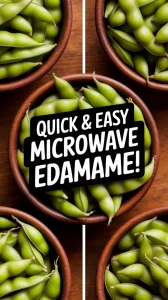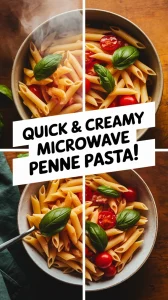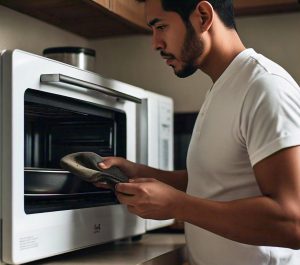Think your microwave is just for reheating leftovers? Think again. It’s a speedy, versatile kitchen sidekick waiting to unleash its full potential.
We’re sharing six fundamental techniques that will transform you from a microwave novice into a confident chef.
Get ready to master everything from perfectly cooked eggs to homemade applesauce.
Jump To:
Mastering the Art Of Microwaving Edamame
We’ve found that microwaving edamame is hands-down the fastest way to enjoy this protein-packed snack. Fresh or frozen, edamame transforms from tough pods to tender perfection in just minutes.
What I found works best is placing the edamame in a microwave-safe bowl with just 2-3 tablespoons of water. Cover tightly with microwave-safe plastic wrap or a vented lid. This creates steam that cooks the beans evenly.
From our own experience, 2-3 minutes on high power works perfectly for a single serving. Frozen edamame needs an extra 30-60 seconds depending on your microwave’s wattage.
One mistake we made early on was overcooking them. Overcooked edamame becomes mushy and loses that satisfying pop when you bite into it. Test one pod first – the beans inside should be bright green and tender but still have a slight bite.
After microwaving, drain any excess water and sprinkle with coarse sea salt. We strongly suggest letting them cool for a minute before digging in – those pods hold heat like tiny green furnaces!
Perfecting Penne Pasta in Your Microwave
Cooking pasta in the microwave might sound odd, but we’ve perfected this technique for quick single servings. No more boiling giant pots of water for just one portion.
The key is using the right pasta-to-water ratio. For every cup of penne, we use 1.5 cups of hot water in a large microwave-safe bowl. The bowl needs to be big enough that the water won’t boil over – trust us on this one.
From my own experience, microwave time equals package directions plus 3-4 minutes. If the box says 8 minutes, microwave for 11-12 minutes on high power. The pasta continues cooking in the hot water even after the microwave stops.
What works best is stopping halfway through to stir. This prevents clumping and ensures even cooking. Add a pinch of salt to the water before cooking – it makes a noticeable difference in flavor.
One thing we learned the hard way – let the pasta sit for 2-3 minutes after microwaving. It finishes cooking and absorbs any remaining water. Drain carefully as both the bowl and water will be extremely hot.
Roasting Peanuts to Crunchy Perfection
Roasting peanuts in the microwave gives you that perfect crunch without heating up your entire kitchen. We’ve found this method works especially well for small batches when you want fresh roasted nuts fast.
Start with raw shelled peanuts spread in a single layer on a microwave-safe plate. No oil needed – the peanuts’ natural oils do the work. For about 1 cup of peanuts, microwave on high for 2 minutes initially.
From our own experience, the secret is stirring every 60-90 seconds after that first burst. This prevents hot spots and ensures even browning. Total time runs 4-6 minutes depending on your microwave’s power and how dark you like them.
What I found works best is listening for subtle popping sounds – that’s when the peanuts are getting perfectly toasted. The smell changes too, becoming nutty and aromatic when they’re done.
One mistake we made was trying to rush the process with higher power settings. This burns the outside while leaving the inside raw. Medium-high power with frequent stirring gives you the best results every time.
Let them cool completely before storing. Hot peanuts lose their crunch quickly if you seal them in a container too soon.
Also See: Easy Microwave Mug Meatloaf: Quick & Delicious!
Creating Simple Homemade Applesauce
Making applesauce in the microwave is one of our favorite beginner techniques. You get homemade goodness in under 10 minutes without any stovetop babysitting or sticky pots to scrub.
What I found works best is using a mix of apple varieties. Combine sweet apples like Gala with tart ones like Granny Smith for complex flavor. 4-5 medium apples make about 2 cups of sauce – perfect for a family.
From my own experience, peeling is optional but coring is essential. Cut apples into small, uniform chunks – about 1-inch pieces cook most evenly. Toss them with 2-3 tablespoons of water and a squeeze of lemon juice to prevent browning.
Microwave on high for 6-8 minutes in a covered microwave-safe bowl. The apples will start breaking down and releasing their natural juices. Stir halfway through to ensure even cooking.
One mistake we made early on was not adding enough liquid. Dry apples can scorch quickly in the microwave. Add another tablespoon of water if the mixture looks too thick during cooking.
After microwaving, mash with a fork for chunky texture or blend smooth if that’s your preference. Season with cinnamon, a pinch of nutmeg, or a drizzle of honey while it’s still warm.
Tempering Chocolate With Microwave Precision
Tempering chocolate in the microwave sounds intimidating, but we’ve cracked the code for beginners. This technique gives you glossy, snap-worthy chocolate without fancy equipment or complicated temperature monitoring.
Start with high-quality chocolate chopped into uniform pieces. We use about 8 ounces for most projects. Place two-thirds of the chocolate in a microwave-safe bowl – keep that remaining third nearby.
From my own experience, 30-second intervals on 50% power prevent overheating disasters. Stir thoroughly between each interval. The chocolate should melt slowly and evenly without any hot spots.
What I found works best is stopping when about 80% of the chocolate has melted. The residual heat will finish melting the rest as you stir. This prevents the chocolate from getting too hot and losing its temper.
One mistake we made repeatedly was rushing this process. Overheated chocolate becomes grainy and dull – there’s no fixing it once it’s ruined. Patience pays off with professional-looking results.
After melting, add the reserved chopped chocolate gradually while stirring. This seeds the melted chocolate with stable crystals. The mixture should cool to about 88-90°F and maintain that glossy appearance we’re after.
Cooking the Perfect Sunny Side Up Eggs
Microwave sunny side up eggs might seem impossible, but we’ve perfected this technique for quick breakfast wins. No pan needed, minimal cleanup, and you get perfectly cooked whites with gloriously runny yolks.
The secret is using a shallow microwave-safe dish or small pie plate. Lightly grease it with butter or cooking spray. Crack the eggs gently to avoid breaking the yolks – fresh eggs work best for this method.
From my own experience, pierce each yolk once with a toothpick. This prevents them from exploding during cooking. We learned this the hard way after cleaning yolk splatter from inside our microwave!
What I found works best is 45 seconds on 70% power for one egg, adding 20-30 seconds for each additional egg. Lower power prevents the whites from becoming rubbery while ensuring even cooking throughout.
One mistake we made early on was using full power. This creates tough, chewy whites and can cause the yolks to burst despite piercing. Medium-high power gives you tender results every time.
Check after the initial cooking time – the whites should be set but the yolks still jiggly. Let them rest for 30 seconds before serving. The residual heat finishes cooking the whites perfectly while keeping those yolks beautifully runny.
Essential Microwave Time Management for Recipes
Mastering microwave timing is what separates beginners from confident microwave cooks. We’ve learned that wattage makes all the difference – a recipe that works perfectly in our 1000-watt microwave might overcook in your 1200-watt model.
From my own experience, the golden rule is start with less time and add more. You can always cook something longer, but you can’t undo overcooked food. I typically use 80% of the recommended time initially, then check and add 15-30 second intervals as needed.
What I found works best is keeping a kitchen timer handy for longer recipes. Microwave displays can be hard to see from across the kitchen. Set your phone timer for stirring intervals – this prevents hot spots that ruin many microwave dishes.
One mistake we made repeatedly was ignoring power levels. Most microwaves default to 100% power, but many recipes work better at 70-80% power for more even heating. Lower power settings take longer but give you better control over the cooking process.
For foods with varying densities, arrange thicker pieces toward the outside of your dish. The microwave’s energy is strongest at the edges of the turntable. We learned this after countless unevenly cooked vegetables!
Always factor in standing time when planning your cooking schedule. Most microwave foods continue cooking for 1-3 minutes after the timer stops. This residual cooking prevents overcooking and helps distribute heat evenly throughout the food.
Selecting Microwave-safe Cookware for Beginners
Choosing the right cookware can make or break your microwave cooking success. We’ve tested countless containers and learned some hard lessons about what works and what definitely doesn’t.
From my own experience, glass and ceramic dishes are your best friends. Pyrex bowls, ceramic plates, and glass measuring cups heat evenly and won’t leach chemicals into your food. They’re also microwave veterans that can handle repeated heating cycles.
What I found works best for beginners is investing in a few key pieces: a large glass mixing bowl, a set of microwave-safe plates, and a vented microwave cover. This basic setup handles 90% of microwave cooking tasks we encounter.
One mistake we made early on was using plastic containers without checking the recycling number. Only plastics marked 1, 2, 4, and 5 are microwave-safe. Avoid anything marked 3, 6, or 7 – these can release harmful chemicals when heated.
Never use metal containers, aluminum foil, or dishes with metallic trim. We learned this the expensive way when sparks damaged our microwave turntable. The metal reflects microwaves and creates dangerous electrical arcing.
Paper plates work for quick reheating, but avoid them for longer cooking times. The paper can break down and create a mess. For covering food, use microwave-safe plastic wrap with vents or a microwave-safe lid rather than regular plastic wrap.
Test any questionable containers with the water test: place the empty container next to a cup of water in the microwave. Heat for one minute on high. If the container gets hot while the water stays cool, it’s not microwave-safe.
Ready to Start Your Microwave Journey?
We’ve covered six fundamental microwave techniques that will transform your cooking experience. From perfectly steamed edamame to silky tempered chocolate, these skills form the foundation of confident microwave cooking. Each technique builds your understanding of power levels, timing, and the unique way microwaves cook food.
Start with one recipe that excites you most, whether it’s the 90-second sunny side up eggs for breakfast or the 5-minute homemade applesauce for dessert. Master that technique first, then gradually work through the others. Remember, microwaving is about precision and patience – keep those 30-second intervals handy and never rush the process. Your microwave is waiting to become your new favorite kitchen companion!









